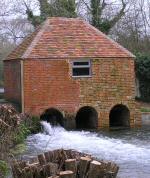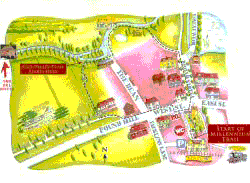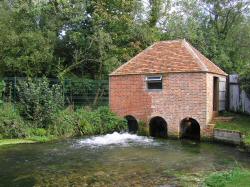THE EEL HOUSE
The next Open Day for the Eel House will be April 2026
One small piece of our history
 The Eel House sits
beside the Wayfarers'
Way footpath in idyllic
woodland in a valley
about a mile and a
half from the centre
of the charming small
market town of Alresford.
It straddles the clean
clear waters of the
tranquil River Alre
with a foot on each
of its banks. It is
a modest but nicely
proportioned building
with a clay-tiled roof
dating from the 1820's
when the Harris family
of nearby Arlebury
Park commissioned this
minor masterpiece of
19th century ingenuity.
Its purpose was to
trap mature eels near
to the start of their
once in a lifetime
three thousand mile
journey.
The Eel House sits
beside the Wayfarers'
Way footpath in idyllic
woodland in a valley
about a mile and a
half from the centre
of the charming small
market town of Alresford.
It straddles the clean
clear waters of the
tranquil River Alre
with a foot on each
of its banks. It is
a modest but nicely
proportioned building
with a clay-tiled roof
dating from the 1820's
when the Harris family
of nearby Arlebury
Park commissioned this
minor masterpiece of
19th century ingenuity.
Its purpose was to
trap mature eels near
to the start of their
once in a lifetime
three thousand mile
journey.
On dark moonless nights between August and November of each year eels set off from the tributaries of Old Alresford Pond, travelling with the prevailing current down the Alre to the River Itchen, into the English Channel and then across the Atlantic Ocean. Their objective is to return to their spawning grounds to breed, deep in the salt waters of the Sargasso Sea, between the Bahamas and Bermuda.
The Eel House contains three water channels running through it. They were built to house the iron grills that were used to trap the eels. There is evidence that these were still in working use in the early 1980's. For more than one hundred and sixty years, on between six and eight dark autumnal nights of the year, the river keeper would arrive at The Eel House. Using a hurricane lamp for illumination he would open his sluices, set his traps and manoeuvre his catch into a boat shaped eel box. When the box was full he would tow it downstream to his keeper's cottage to await the arrival of merchants from as far away as Billingsgate in London who took the eels away in tanks to be sold, while still alive, at fish markets.
Buildings constructed specifically for eel trapping are extremely rare in the United Kingdom. There is only one other such house that features in the English Heritage register of listed buildings and a Google internet search currently throws up no others. The Eel House at Alresford is certainly a unique historic building.
Fundraising is ongoing to complete the restoration of the inside and visitors will be able to see what needs to be done together with a small exhibition on eels and the eel house. Entry is free but donations would be appreciated.
Directions
 Alresford is a 'T' shaped small town. From the central T-junction of Broad Street
with East and West Streets, head down the hill on West Street. Take the first
right into The Dean. At the bottom of The Dean turn left onto the footpath
alongside the clear waters of the River Alre. The Eel House is 500 metres along
this Wayfarers' Way path. Please note it is not on Alresford's Millennium Trail.
Alresford is a 'T' shaped small town. From the central T-junction of Broad Street
with East and West Streets, head down the hill on West Street. Take the first
right into The Dean. At the bottom of The Dean turn left onto the footpath
alongside the clear waters of the River Alre. The Eel House is 500 metres along
this Wayfarers' Way path. Please note it is not on Alresford's Millennium Trail.
Click on the map to enlarge.
Restoration
In 2006 during work to remove the ivy that completely engulfed the building, it became apparent that the southwest corner of the building was collapsing. The back scouring of the river current, coupled with the energetic roots of a nearby ash tree, had completely undermined part of the building and was making rapid inroads into the rest of the foundations. There was a distinct possibility then that it would soon crumble into the River Alre; all that was holding it up were strands of ivy. As The Eel House is situated at a flow control point, if it had collapsed, the upstream water levels would have dropped catastrophically ruining the tranquillity of the river walks around Alresford and the wildlife habitat of Old Alresford Pond.
The owner moved swiftly to have the building propped up and consultations between all interested parties then followed. These were somewhat complicated as the building is owned by one party, another owns the surrounding land and a third the river fishing rights. Also involved were the Environment Agency and Natural England as protectors of the delicate and sensitive environment of the River Alre and its surrounds.
 Members of The Alresford
Society were determined
that the building should
be saved if at all
possible and two individuals
underwrote the majority
of the £15,000
that was needed for
the initial and urgent
funding of the restoration.
With much goodwill
from all parties involved,
the eventual outcome
was that the New Alresford
Town Trust was granted
a 99-year lease on
the building at a peppercorn
rent. This enabled
a search for charitable
grants and tax efficient
donations for the project
and it also ensured
the future of The Eel
House.
Members of The Alresford
Society were determined
that the building should
be saved if at all
possible and two individuals
underwrote the majority
of the £15,000
that was needed for
the initial and urgent
funding of the restoration.
With much goodwill
from all parties involved,
the eventual outcome
was that the New Alresford
Town Trust was granted
a 99-year lease on
the building at a peppercorn
rent. This enabled
a search for charitable
grants and tax efficient
donations for the project
and it also ensured
the future of The Eel
House.
A restoration team was set up, under the authority of the Town Trust, comprising three Town Trustees and two members of The Alresford Society plus the owner of the building and the landowner, to manage the repair, maintenance and future safety of the building. Duncan Grant of the Radley House Partnership and Michael Clarke, a senior conservation officer with Hampshire County Council provide this team with expert advice.
Initial funding was raised by grants from Hampshire County Council, Winchester City Council, New Alresford Town Council and The Alresford Society, augmented by generous donations from more than fifty local individuals and corporate bodies. The first step was to clear the loose and collapsed foundations and replace them with an extensive concrete 'pad' so that the five-feet deep water-scoured void beneath the building was effectively filled. An under scouring of the adjacent Wayfarers' Way footpath was also repaired at the same time.
The second step was to restore the external structure of the building, rebuilding and re-pointing the walls together with replacing the roof tiles. New railings have also been installed allowing a better view of the structure from the Wayfarers' Way footpath. Once this work was completed the Mayor of Winchester was invited to officially opened The Eel House in April 2008. It was first opened to the public at Easter 2009 and has had over 3000 visitors since then.
The remaining challenge
With the building now secure and with the exterior structure repaired, work is in hand to restore the building to working use. The aim is to make The Eel House, as far as possible, exactly as it was in past and eel traps are being installed together with equipping the interior of the building.
Please note that this is not a restoration with a commercial objective, any eels caught in the traps will not feature on restaurant menus, they will be returned to the waters of the Alre.
The Eel traps have now been restored but essential work still remains to be done on the sluices. Not appreciated by many people the primary function of the Eel House now is to control the flow of water in the river and its level upstream. Currently this is undertaken using timber and plastic sheet which is laborious and time consuming and is only carried out when absolutely essential. This does result in the river path flooding from time-to-time.
The next step in the restoration will involve the re-building of the sluice system and it is estimated that an additional £15,000 is needed to complete this work. Once complete the flow of the river will be easy to control and upstream flooding should be a thing of the past.
The Eel House is intended to stand not only as a reminder of the way some of our ancestors made a living but also to be available for present day educational and research uses.
If you are interested in making a donation or in helping to raise funds in any way please contact the Trust Clerk.
If you are interested in volunteering to help on Open Days at The Eel House please contact the Trust Clerk.
2026 Open Days
During 2026 it is planned that the Eel House will be open on six days
which will be published as soon as they are agreed
Entry is free but donations, to fund further necessary restoration work, will be much appreciated.
A special opening can be arranged for groups of 10 - 15 people. Please apply to the Trust Clerk for details